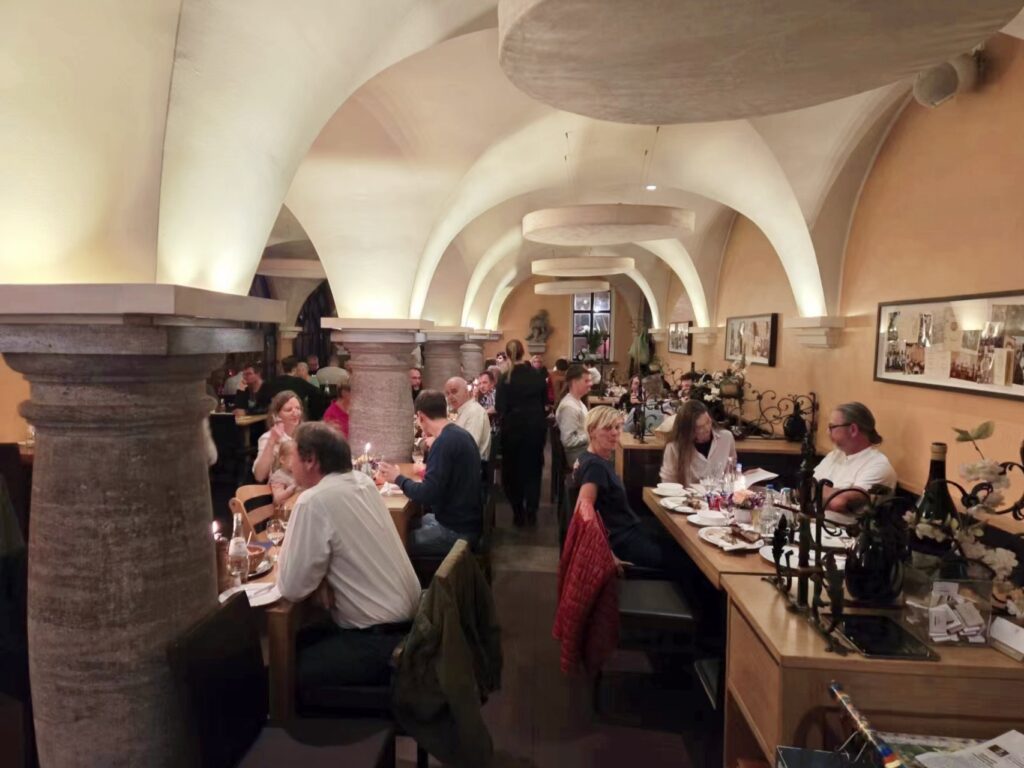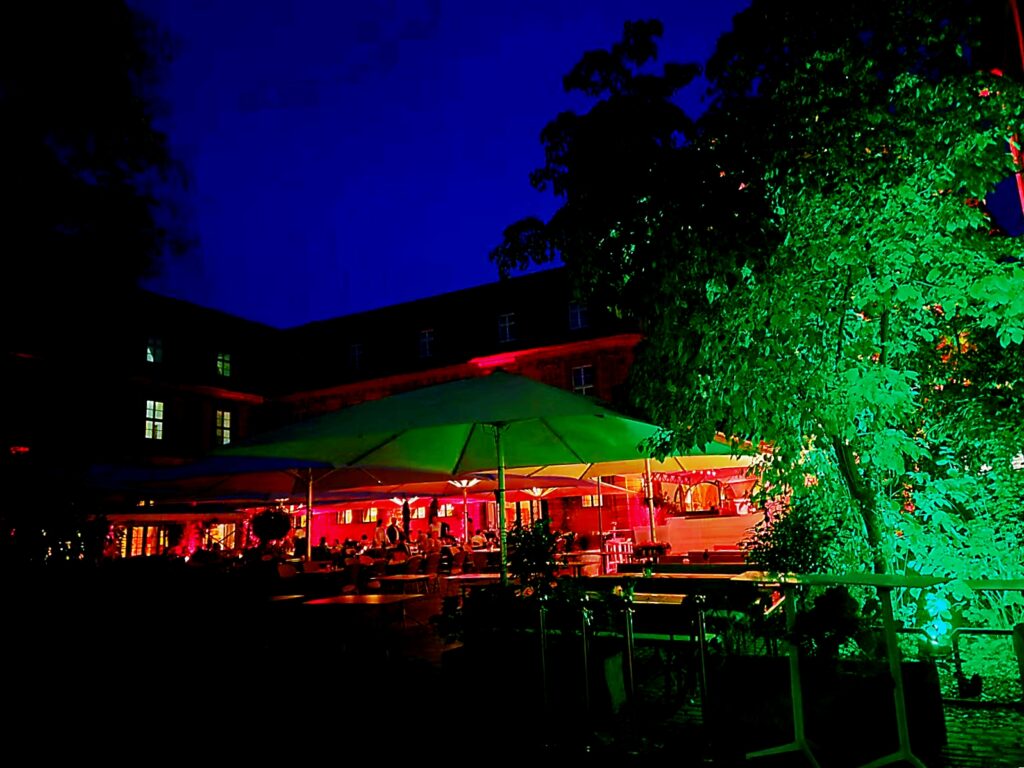Bürgerspital Weinstube
Theaterstraße 19
97070 Würzburg, Germany
Tel. +49 0931 35 288 0

The dishes
Crispy pike perch, on cream of jasmine rice, purple cauliflower, potato chips and kaffir lime-curry foam
“Wiener Schnitzel” from the veal with fried potatoes and cowberries
Variation of cheese with fig mustard and baguette
Affogato with double espresso and whipped cream

One of the most popular and best inns in Würzburg, the charming Bürgerspital Weinstube offers a mostly traditional Franken cuisine (though international dishes are available too) and a large choice of wines from the Bürgerspital. Chef Alexander Wiesenegg (the Wiesenegg family is now in its second generation running the weinstube since 1986) embodies the house motto of “tradition meets modernity” and the times I’ve been at the weinstube I have always found his cooking (ranging from classic dishes such as Blaue Zipfel and Schäufele to fried pikeperch) to be spot-on, and served in the traditionally hearty German portions. Blaue Zipfel refers to a dish of Franken sausages, generally 15-20 centimeters long (six to eight inches), coarsely chopped and flavourful, generally pan-roasted or cooked in a broth of vinegar, wine and onions. It’s called “Blau Zipfel” because the vinegar bath will turn the pink sausage into a blueish-looking one. Schäufele, also known as “Schüfeli”, “Schäuferla” or “Schäufelchen” is a pork shoulder dish typical of southern Germany, and in particular traditional to Würzburg and the Franken, that can be smoked or cured before boiling or roasting. At the Bürgerspital Weinstube they are especially proud of their steaks, and you’ll find all the classic cuts, from the T-bone to the tomahawk to the bone in-ribeye. The restaurant is actually large, and patrons can choose to eat in different areas, including the wine bar (nicely woodsy, cozy and rustic) to the arcades area (the Bürgerzimmer), where despite its attempt at being more modern and stylish it can get both quite busy and noisy, and last but not least the very pretty, even romantic inner courtyard (that is always my pick, and it should be yours too, anytime there is good warm weather).

The dishes I have tried at the weinstube have always been just what the doctor ordered for anyone in search of tradition and heartiness, not to mention flavour. The crispy pike perch is sheer foodie heaven for anybody, like me, who likes freshwater fish. The pike perch is a beautiful and very fine eating fish more commonly known in Canada as walleye, and in the USA as pickerel. Now, if you know me at all, and are acquainted with my body of work (especially all the books and articles on Italian grape varieties), you are aware of how complicated these grape varieties can get. Well… if you thought Italy’s grape varieties were hard to wrap your head around, then let me just make you feel better and show you how it’s not any easier with fish. For example, that previous statement relative to the pike perch is an orgy of mistaken identities: first off, it’s not true that the pike perch is the same thing as a walleye and a pickerel. And wouldn’t you know it, it’s a matter of biotypes, if not downright different varieties: the European pike perch is actually more accurately called zander, and though it is very, very similar to a walleye, it is not the same fish (the zander has tiger-like stripes that make it look a lot more like a perch, though it’s a much bigger and sleeker fish, while the walleye is a more uniform yellow-gold colour). Clearly, I will spare you now and won’t get into the fact that there exist two different walleyes, the blue and the yellow (but I should perhaps write “existed” given the former is rumored to be now extinct). Second, the pickerel and the walleye are completely different fish: the true pickerel is a very close relative of the pike and a member of that family (and it looks like a pike too: the most famous of all pickerels is the chain pickerel, because of its chainmail-like striations) so the American name of “pickerel” for pike perch is actually a misnomer. Got that? Well, the practical take home message is that all three fish, Canadian and American walleye; European zander; and pickerel, are all very fine eating fish. It follows that for all my readers who aren’t into fishing or amateur/professional ichthyologists that’s probably all you/they really need to know. My pike perch/zander was beautifully crispy and tasty, not to mention precisely cooked. Even better was the Wiener Schnitzel, crunchy on the outside and moist on the inside, a textbook rendition of this dish (the accompanying potatoes were also remarkably good). Wiener Schnitzel is one of the world’s most famous meat dishes, and when it’s done this well it really is a gift from the epicurean deities to mankind.

The Winer Schnitzel at the Bürgerspital Weinstube is truly delicious and well-cooked. It’s a world-famous dish of course, so most is us know what to expect when we order it: even better, we have parameters by which its quality and success can be gauged and evaluated. Apparently, the Wiener Schnitzel, that is clearly named after Austria’s capital, Wien, and represents one of Austria’s national dishes. The first mention of a the dish in Austria apparently dates back to an 1831 cookbook written by MariaAnna Neudecker, something that clashes with the long-held theory that the Wiener Schnitzel derives from Italy’s cotoletta alla Milanese, also a breaded veal cutlet, but this parentage is something that many Austrians understandably refuse to accept. Legend has it that Field Marshal Joseph Radetzky tried the Italian dish during his campaigns (Milan was under Austrian rule for along time, until) , and brought the recipe back to Wien upon his return to Austria in 1857. There is no doubt that the Italian cotoletta has been around for much longer, given that already in 1148 a document cites a luncheon held by the monks of Sant’Ambrogio in which one of the dishes was the lombolos cum panitio, or breaded veal.

As always with such stories that involve national pride and haven’t been precisely documented over time, it is hard to know today exactly what was what and what is: for sure, there are discrepancies in the reports of when the term Wiener Schnitzel (also written as Wienerschnitzel) first appears: some say 1871, others 1893. Clearly, it is very possible that people who write on the subject are getting their fried meats confused: for example, there are examples of Austrian breaded fried meats that predate the birth of the Wiener Schnitzel, such as the backhendl (there was even a Wiener Backhendl), so when people write that the Wiener Schnitzel appeared before Radetzky’s return to Austria, we don’t really know if what was being described before was a true Wiener Schnitzel, or an ancestor of sorts, or something completely unrelated. Nevertheless, you understand that if people can’t even agree when the existence of the thing is first documented officially, then finding out about Wiener Schnitzel’s real origin is next to impossible. Last but not least, let me point out that there are salient differences between the cotoletta alla Milanese and the Wiener Schnitzel: the two are not one and the same. The Wiener Schnitzel is usually thinner than the cotoletta, which is characterized by a much thicker cut of meat; the piece of meat used is different too [the cotoletta can be made only with the loin/sirloin, and therefore always comes with the meat’s bone, while the schnitzel does not (usually) have the bone and is therefore made from totally different cuts of meat, most commonly the filet or the rump]; and while in Austria the schnitzel was historically fried in lard, later substituted with oil, in Italy it was and is always and only fried in butter. In Austria they will also make schnitzels with pork meat, something that in Italy would get you unceremoniously thrown out of the restaurant. Last but not least, note that the preparation of neither one of the two dishes, as has instead been erroneously written just about everywhere, requires that the meat be pounded to death in order to flatten it (that’s a more modern development used with poor-quality meat) or the use of flour (again, a poor man’s version of the real schnitzel and real cotoletta, that are, or ought to be, flour-free).

The wines
Bürgerspital 2022 Weisser Burgunder Würzburger Stein Trocken Franken 93
Bürgerspital 2006 Rieslaner Würzburger Abstleite Beerenauslese 94
I washed all this down with the Bürgerspital 2022 Weisser Burgunder Würzburger Stein Trocken Franken, a lovely Pinot Blanc that is light and crisp. It makes a perfect aperitif, but is deep and complex enough to also go well with most fish and vegetable dishes that are simply prepared. The Bürgerspital 2006 Rieslaner Würzburger Abstleite Beerenauslese, is luscious but vibrant sweet wine blessed with copious limey acidity. Rieslaner’s popularity is a bit on the wane with producers after its heyday in the late 90s and early 2000s but it does make marvelous high-acid sweet wines, as is the case with this beauty.

In ultimate analysis, I ate on two different occasions at the Bürgerspital Weinstuibe recently and came away satiated and impressed both times. After all, there’s a lot to be said for a place that knows what its patrons want and expect from it, and does that well. Furthermore, that it does so at very reasonable prices (wines included). What can I say more? Only that my hat’s off, so much so that I look forward to eating at the Bürgerspital Weinstube again. And again.





